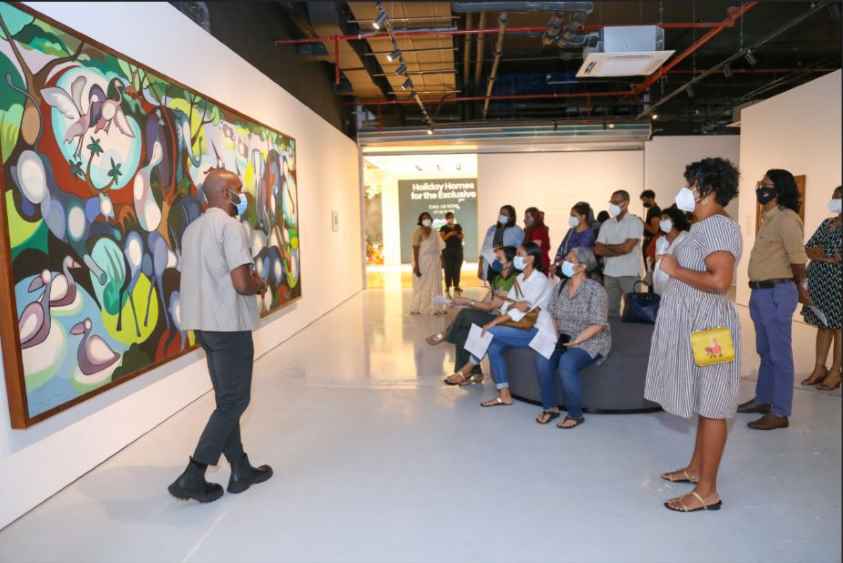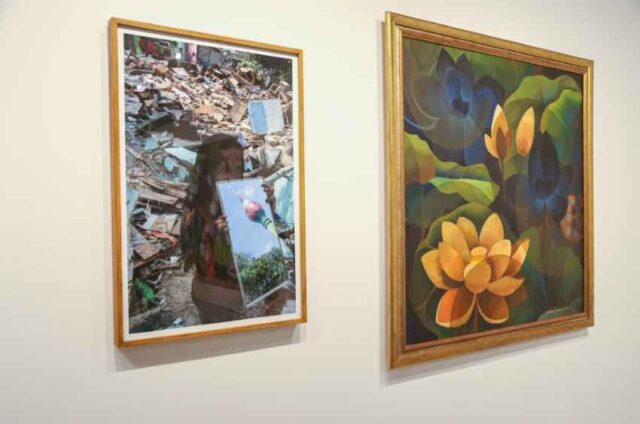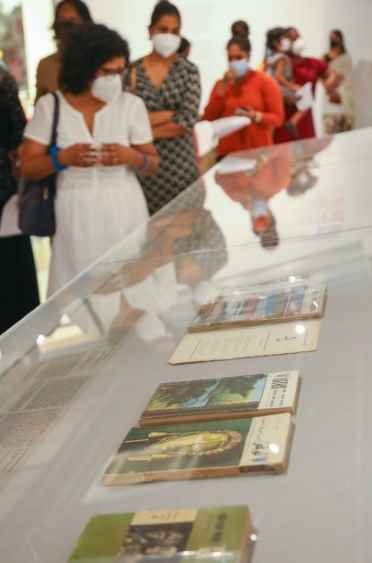
‘Encounters’ by the Museum of Modern and Contemporary Art Sri Lanka (MMCA Sri Lanka) takes one on a journey of multiple encounters. Display 1 of this exhibition follows the historical trail of Sri Lanka’s emergence in the international arena through diplomatic and geopolitical relationships. The artworks and artefacts on display, from as early as the 1960s, documents this development through several milestones in the island’s history.
The first Asian-African Conference, titled the Bandung Conference, took place in 1955 to bring together a group of Asian-African nations representing 54% of the world’s population. The conference was a precursor to the creation of the Non-Aligned Movement (NAM) in 1961, amidst the steeping Cold War between pro-Soviet and pro-USA countries. Sri Lanka was a part of the coalition of nations that formed the NAM to recognize their shared post-independence economic and political struggles.

‘The Bandung Conference’ (1955) by Aubrey Collette (1920–1992) caricatures those in attendance at the Bandung Conference. Sri Lankan Prime Minister General Sir John Kotelawala (1897–1980) is foregrounded next to prominent figures of the NAM, including President of Egypt Gamal Abdel Nasser (1918–1970), and Indian Prime Minister Jawaharlal Nehru (1889–1964). Of the 29 government representatives, Collette also foregrounds the Chinese Premier and Foreign Minister Zhou Enlai (1898–1976). The Chinese Premier is depicted at the corner of the work alluding to China’s emerging influence on conversations related to economic development that was part of the larger agenda of decolonization, self-rule, and non-aggression.
Under the leadership of Prime Minister Sirimavo Bandaranaike (1916–2000), Sri Lanka hosted the 5th Summit of the Non-Aligned Movement with 86 countries in participation, on 16–19 August 1976 in Colombo. Bandaranaike was astute with marketing initiatives, and commissioned artistic talent to showcase Sri Lanka through many media such as artwork, commemorative artefacts, and literary publications aligned with the spirit of the NAM.
A central piece of art commissioned for this event is a painting by Senaka Senanayake. This large-scale work was hung in the lobby of Hotel Lanka Oberoi (Cinnamon Grand), in the line of sight of visiting dignitaries. In this painting, animals roam freely within a fantastical landscape visualised through a palette of vibrant greens and browns with hues of aqua blue, grey, and off-white. All the facial features of the animals are noticeably absent, creating a sense of uniformity between the species. Similarly, their bodies are reduced to radiating discs of flat colour, marking out their commonality rather than difference. Such details offer an image of the nation in equilibrium with the forces of nature, while underlining the idealism and optimism held out for the Non-Aligned Movement.
Moreover, Bandaranaike had commemorative Five and Two Rupee coins issued by the government of Sri Lanka. The coins depict the Bandaranaike Memorial International Conference Hall (BMICH), established in memory of the late Prime Minister S.W.R.D. Bandaranaike (1899–1959). Built between 1970 and 1973, the BMICH was gifted to Sri Lanka by the People’s Republic of China. This was in response to a request made in 1968 by Premier Bandaranaike for a fully equipped conference hall, as part of preparations to host the 5th Non-Aligned Summit Conference. The coins commemorate not only the Summit, but also the diplomatic relationship that was being laid between China and Sri Lanka.

Following the declaration of Sri Lanka as a republic in May 1972, a national emblem was designed by the ‘National Emblem and Flag Design Committee’. The emblem included the petals of the blue lotus flower which is a symbol of purity and detachment in Buddhist culture.
The Lotus imagery makes an appearance in two publications from the period, both of which are on view in Display 1 of ‘Encounters’. In 1968 the Afro-Asian Writers’ Bureau published a bulletin entitled ‘The Call,’ and a trilingual quarterly journal entitled ‘Afro-Asian Writings.’ The latter was renamed as ‘Lotus: Afro-Asian Writings’ in the 1970s, and is considered as one of the most important and prolific contributions to Cold War era anti-colonial ‘Third Worldist’ literature.
It is evident through these many ‘Encounters’, that Sri Lanka has risen above murky waters and established strong diplomatic ties across the globe. ‘Encounters’ so richly raises our awareness of where Sri Lanka was headed between the 60s and the 70s. It exemplifies what 50 years of encounters and leadership can manifest and create.
For more information on the Museum of Modern and Contemporary Art Sri Lanka, visit www.mmca-srilanka.org or follow them on Facebook at www.facebook.com/mmcasrilanka and Instagram at https://www.instagram.com/mmcasrilanka/


